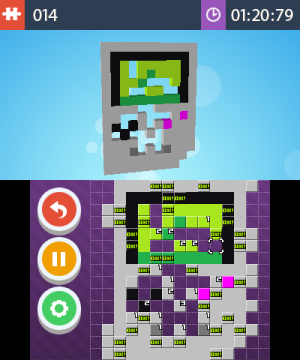Tappingo Review
Firing up Tappingo for the first time, you cannot help but think about Picross, Nintendo’s puzzle series appropriated from the popular nonogram logic puzzles popularized in 1980’s Japan. It involves “colouring in” pixel art compositions by extending coloured blocks in accordance to the numeric value on each one.
 Unlike its obvious inspiration, Tappingo will tell you when you are doing things right or wrong. Correctly stretching a “6” block horizontally along six empty spaces on the puzzle will result in the “6” changing to a satisfying “OK”. The game changer comes from the fact that once you drag a pixel-block in a particular direction, it will extend until it reaches another solid pixel, or the outer edge of the lower 3DS screen where the action takes place. Although the top of the clamshell shows you the progress of your little pixel-art masterpiece, it is seldom referred to in completing the puzzles. The drawing is governed by closely planning your moves, thus ensuring that each block reaches the correct length, with the top screen only informing you of what you’re constructing.
Unlike its obvious inspiration, Tappingo will tell you when you are doing things right or wrong. Correctly stretching a “6” block horizontally along six empty spaces on the puzzle will result in the “6” changing to a satisfying “OK”. The game changer comes from the fact that once you drag a pixel-block in a particular direction, it will extend until it reaches another solid pixel, or the outer edge of the lower 3DS screen where the action takes place. Although the top of the clamshell shows you the progress of your little pixel-art masterpiece, it is seldom referred to in completing the puzzles. The drawing is governed by closely planning your moves, thus ensuring that each block reaches the correct length, with the top screen only informing you of what you’re constructing.
Things start out small, with a tutorial level asking you to fill in a pixelated love heart (aww). Once this stage is out of the way, you have carte blanche to take on any of the 100 levels Tappingo has to offer. As you may imagine, things get suitably tricky with the difficulty spiking quite significantly after about the fifth stage. The further you progress, the larger the pictures; the longer you play, the more apparent the the subtle flaws become. Firstly, the gameplay is hamstrung by its lack of any possible variety other than in the complexity of the artwork. Your movement is restricted to the four cardinal directions, and at any particular stage all your brain is really forced to work out is which direction a pixel needs to be aimed in, and how you are going to halt its trajectory to satisfy the strict numeric value required.
 The other problem that threatens to derail what is otherwise an inoffensive puzzling experience is the screen layout. Annoyingly, there is no option to zoom in and out on the lower screen. When you are working on something small, like a padlock, or a clownfish, that is fine, but as soon as the puzzle pics start filling the entire screen – like a particularly frustrating octopus – the game zooms out of its own accord, shrinking the pixels down to a miniscule size. The controls are already fairly awkward when using the stylus, and you will find yourself accidentally touching the wrong block time and time again. This wouldn’t be an issue if there was an “UNDO” option, however the lack of such a function means that touching the incorrect pixel will retract the line, and potentially set off a chain reaction with any other connected moves you have made, thus knackering your progress and forcing a restart of the entire level. The diminutive pixels when the action is zoomed out make these mistakes even more likely.
The other problem that threatens to derail what is otherwise an inoffensive puzzling experience is the screen layout. Annoyingly, there is no option to zoom in and out on the lower screen. When you are working on something small, like a padlock, or a clownfish, that is fine, but as soon as the puzzle pics start filling the entire screen – like a particularly frustrating octopus – the game zooms out of its own accord, shrinking the pixels down to a miniscule size. The controls are already fairly awkward when using the stylus, and you will find yourself accidentally touching the wrong block time and time again. This wouldn’t be an issue if there was an “UNDO” option, however the lack of such a function means that touching the incorrect pixel will retract the line, and potentially set off a chain reaction with any other connected moves you have made, thus knackering your progress and forcing a restart of the entire level. The diminutive pixels when the action is zoomed out make these mistakes even more likely.
As everything is unlocked from the jump off, there is very little in the way of reply value. Levels are against the clock, yet there are no incentives for finishing in super-quick time. Sure, you could challenge your own personal best – but how badly do you really see yourself wanting to shave milliseconds off that pixel-art watermelon slice? It is also begging for some kind of level editor or creative function. How fun would it be to draw your own mini-masterpieces, and then challenge your friends and family to fill in the blanks?
VERDICT: You can’t knock the simple charm of Tappingo too much – it is still a cheerful and breezy little number, and some of the pictures will genuinely make you smile (one of them depicts a much-loved Ninty console of yore). Just don’t expect oodles of options, and be prepared for the controls to cause you some degree of annoyance.

DECENT. A 6/10 indicates that, while this game could be much better, it still has a fair amount to offer the player. It might be an interesting title sabotaged by its own ambition, or a game denied greater praise by some questionable design choices. Don’t avoid it outright, but approach it with caution.
Review code provided by publisher.




